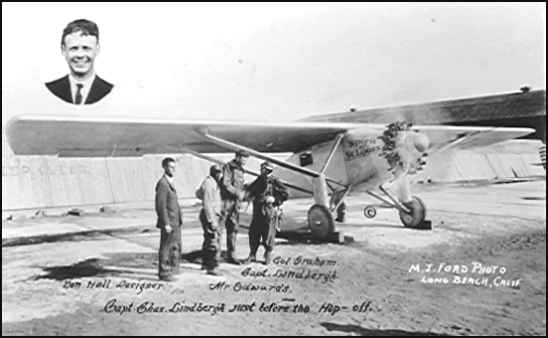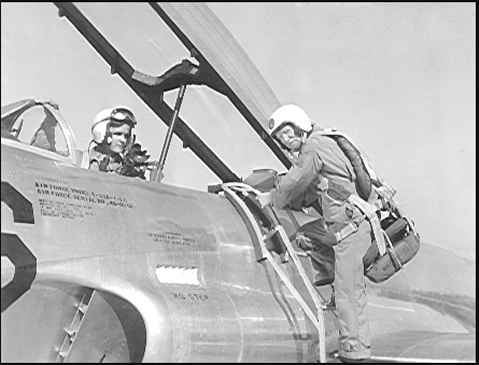

1874-1952 |
 |
 |
 |
Collection of Margaret Perry Graham, 6-12-04 |
 |
Left to Right: Ben Hall, A. J. Edwards, Capt. Lindbergh, Col. Graham Collection of Margaret Perry Graham, 6-12-04 |
 |
Collection of Margaret Perry Graham, 6-12-04 |
|
When the controls were turned over, Colonel Graham found them light and responsive. The wheels touch at 118 miles. He wonders if anyone else his age (76 now) has flown any slower or any faster. First Lieutenant Graham quit the 22d Infantry for the air back in January, 1912, to join the air force of that day at College Park. Then, according to the custom, he spent some time at the Wright factory watching the construction of another Wright for the Army. Imagine today's speeds! The year before Graham quit the Infantry to streak through the sky at 40 miles an hour, Wilbur Wright was protesting the conditions of the Bennett International race to the Paris Herald and refused to enter a machine in the 1911 contest won by Weyman at 78 miles an hour. "Flying at the highest speed for which it is possible to design a machine is unreasonably dangerous, * * * No one dares build the fastest machines he knows how to build." In August of 1912 he had a share in those first air maneuvers when radio was, perhaps, used for the first time in this country in such exercises. Back at College Park he saw Lincoln Beachey put the Army's rebuilt Curtiss (Signal Coprs #2) through its paces, Beachey's "reckless flying" causing the Chief Signal Officer to issue an order prohibiting Beachey from flying any more Government machines. When the group moved to Augusta that winter, Graham and his associates saw the discouraging efforts of Brindley to put the Wright D through its tests. Then to Texas City for the Second Division maneuvers, the first air-ground cooperation operations and his cross-country solo flight Texas City to Houston and return. He left the embryo air service June 30 and returned to the Infantry for a spell. Then back to flying in 1918 and on through to Dec. 15, 1929, when he retired at his own request after more than 30 years' service. Colonel Graham has been in Washington for some time in Operation Prostatectomy, the enemy being entirely wiped out. . courtesy of Steve Remington - CollectAir |
 |
Collection of Margaret Perry Graham, 6-12-04 |
 |
From Early Bird Chirp, June, 1957 |
from Margaret Yearwood Hutchinson, 6-12-04 For the past three years, I have had the honor of caring for Margaret Perry Graham in a guardianship role. She has recently passed away, (April 21, 2004), after a lengthy illness. She has left her personal effects to me to do with whatever I see fit. After browsing through her family photographs and personal papers, I have concluded that her family was an important one. Her father was Lt. Col. Harry Graham, an Early Bird aviator, and her grandfather was Barton W. Perry, another important military man. Margaret was an only child, and she never married. Her mother, Grace Perry, was also an only child. I would love to honor Margaret by having her distinguished family memorialized in a musuem, or other such place. Since Big Bear was the city that Margaret called home, I feel that it would be a good place to have a musuem display about her family. I am writing to you because I found your email associated with Harry T. Graham on the Early Bird site. He apparently already has a plaque and memorial in a park in Big Bear. Is that near the museum? Here are some question I have for you. 1. Are you interested in information about Harry Graham? 2. Would you or the museum be interested in making a display honoring the Perry and Graham families? 3. Would information and photographs made available to you, be also available for others studying without charge? (other than nominal copy machine charges) I am attaching a couple of the many pictures that I have access to. I also have Harry's Aero Club of America License #152, Dated Aug. 7, 1912. I am sending you a copy. As I stated earlier, I am tring to figure out a way to memorialize Margaret Perry Graham's family, and share her rich history with those who might be interested. Margaret would not have liked anyone to profit from these pictures, except maybe a museum. If you are interested in working with me to get these pictures and information in your museum, please feel free to contact me: :Margaret Yearwood Hutchinson. Editor's Note: I hope to help Margaret accomplish her project. If you are interested in helping, please let me know and I will forward your message to her. |
Christopher J. Pohlhaus of the Wilbur & Orville Wright Digitizing Project is looking for descendents of Harry T. Graham. If you can help, please contact: Christopher J. Pohlhaus Wilbur & Orville Wright Digitizing Project Manuscript Division Library of Congress cpoh@loc.gov 202-707-5971 |
|
From The Early Birds of Aviation Roster of Members January 1, 1993 If you have any information on this Early Bird, please contact me. E-mail to Ralph Cooper Back 

|